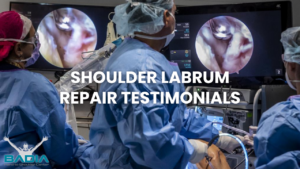

The causes, however, can be very different and require a thorough diagnostic process to understand the underlying problem and lead to a solution.
Young active patients often feel that shoulder pain stems from overuse. This may be the case, but it is important to understand why. Current exercise regiments usually emphasize strengthening the deltoid muscles, but the rotator cuff is largely ignored. This leads to an instability syndrome that can cause pain and even worse, a mechanical deficiency of the shoulder joint. If the pain is a chronic problem, with no history of a single traumatic event, the patient will usually respond to strengthening therapy. This therapy will require diligence from the patient and the therapist.
An acute injury, such as a fall or an impact on a raised arm, may lead to a discrete injury that could require repair. When an acute injury leads to persistent pain, we often order an MRI, which is a diagnostic tool that examines the soft tissue deep in the shoulder. An ordinary x-ray examines bony structures, and often displays as normal in people with painful shoulder symptoms. The MRI can often indicate the severity of the soft tissue injury and can dictate whether continued conservative treatment (anti-inflammatories, corticosteroid injections, and therapy) is required, or if surgical intervention is warranted. A torn cartilage rim or tendon rupture will usually not get better on its own; hence a mechanical solution may be necessary.
In today’s modern age of medicine, we can solve many of these problems through arthroscopic surgery. This procedure allows the joint to be visualized with a small camera inserted through tiny holes in the skin outside the joint. This procedure minimizes scarring, improves the surgeon’s visualization of the problem, and speeds the recovery. In certain cases, an open incision may be required depending on the severity and location of the problem.
Older patients often attribute their shoulder pain to “arthritis”. In fact, arthritis in the shoulder joint (particularly the ball and cup joint) is rather rare. Arthritis is the loss of cartilage in a joint that leads to bone grinding against bone. This osteoarthritis condition is more commonly seen in the knee, hip, or even the base of the thumb, but is much less common in the shoulder.

Monday- Friday: 8:30AM- 5:00 PM
Saturday- Sunday: Closed